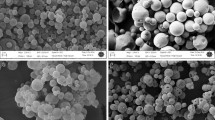Abstract
This paper describes an investigation of the use of poly(lactic/glycolic acid) polymers for long-term delivery of high molecular weight, water-soluble proteins. Poly(lactic/glycolic acid) (PLGA) microspheres, containing (fluorescein isothiocyanate)-labeled bovine serum albumin and (fluorescein isothiocyanate)-labeled horseradish peroxidase, were prepared by a modified solvent evaporation method using a double emulsion. The microspheres were spherical with diameters of 55–95 µm and encapsulated more than 90% of the protein. The preparation method was gentle and maintained enzyme activity and protein solubility. Stability studies showed that the encapsulation of an enzyme inside PLGA microspheres can protect them from activity loss. When not placed inside PLGA microspheres, (fluorescein isothiocyanate)-labeled horseradish peroxidase lost 80% of its activity in solution at 37°C in a few days, whereas inside the PLGA microspheres it retained more than 55% of its activity after 21 days of incubation at 37°C. In vitro release studies revealed that different release profiles (i.e., near-constant or biphasic) and release rates can be achieved by simply modifying factors in the preparation procedure such as mixing rate and volume of inner water and organic phases. Degradation studies by scanning electron microscopy and gel-permeation chromatography suggested that the mechanism responsible for protein release is mainly through matrix erosion.
Similar content being viewed by others
REFERENCES
A. K. Schneider. Polylactide Sutures. US Patent 3 636 956 (1972).
D. L. Wise, T. D. Fellman, J. E. Sanderson, and R. L. Wentworth. Lactic/glycolic acid polymers. In G. Gregoriadis (ed.), Drug Carriers in Biology and Medicine, Academic Press, London, 1979, pp. 237–270.
D. K. Gilding. Biodegradable polymers. Biocompat. Clin. Implant. Mater. 2:209–232 (1981).
D. L. Wise, T. M. Jackanics, H. A. Nash, and J. B. Gregory. Polylactic acid as a biodegradable carrier for contraceptive steroids. Contracepton 8:227–234 (1973).
L. R. Beck, V. Z. Pope, D. R. Cowsar, D. H. Lewis, and T. R. Tice. Evaluation of a new three-month contraceptive microsphere system in primates. J. Contracept. Deliv. Syst. 1:79–82 (1980).
C. G. Pitt, T. A. Marks, and A. Schindler. Biodegradable drug delivery systems based on aliphatic polymers: Application to contraceptives and narcotic antagonists. In R. W. Baker (ed.), Controlled Release of Bioactive Agents, Academic Press New York, 1980, pp. 19–43.
F. G. Hutchinson and B. J. A. Furr. Biodegradable polymers for the sustained release of peptides. Biochem. Soc. Trans. 13:520–523 (1985).
L. M. Sanders, B. A. Kell, G. I. McRae, and G. W. Whitehead. Prolonged controlled release of Naferlin, a luteinizing hormone-releasing hormone analogue, from biodegradable polymeric implants: Influence of composition and molecular weight of polymer. J. Pharm. Sci. 75:356–360 (1986).
Y. Ogawa, H. Okada, M. Yamamoto, and T. Shimamoto. In vivo release profiles of leuprolide acetate from microcapsules prepared with polylactic acids or copoly(lactic/glycolic) acids and in vivo degradation of these polymers. Chem. Pharm. Bull. 36:2576–2581 (1988).
L. Bohn. Compatible polymers. In J. Brandrup and E. H. Immergut (eds.), Polymer Handbook, 2nd ed., III 211, John Wiley and Sons, New York, 1975.
Y. Ogawa, M. Yamamoto, H. Okada, T. Yashiki, and T. Shimamoto. A new technique to efficiently entrap leuprolide acetate into microcapsules of polylactic acid or copoly (lactic/glycolic) acid. Chem. Pharm. Bull. 36:1095–1103 (1988).
A. M. Reed and D. K. Gilding. Biodegradable polymers for the use in surgery—Poly(glycolic)/poly(lactic acid) homo-and copolymers. 2. In vitro degradation. Polymer 22:494–498 (1981).
K. Makino, M. Arakawa, and T. Kondo. Preparation and in vitro degradation properties of polylactides microcapsules. Chem Pharm. Bull. 33:1195–1201 (1985).
R. Langer and J. Folkman. Polymers for the sustained release of proteins and other macromolecules. Nature 263:797–800 (1976).
R. Langer. New methods of drug delivery. Science 249:1527–1533 (1990).
E. Mathiowitz and R. Langer. Polyanhydride microspheres as drug carriers. I. Hot melt microencapsulation. J. Control. Release 5:13–22 (1987).
Author information
Authors and Affiliations
Rights and permissions
About this article
Cite this article
Cohen, S., Yoshioka, T., Lucarelli, M. et al. Controlled Delivery Systems for Proteins Based on Poly(Lactic/Glycolic Acid) Microspheres. Pharm Res 8, 713–720 (1991). https://doi.org/10.1023/A:1015841715384
Issue Date:
DOI: https://doi.org/10.1023/A:1015841715384




